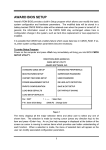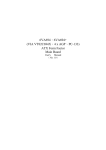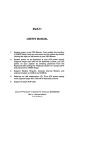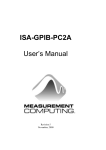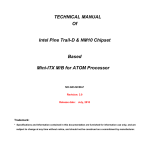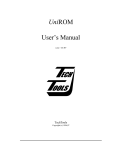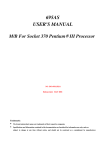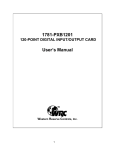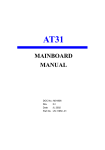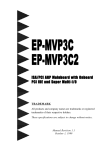Download 6va693am ver1.1
Transcript
6VA693AM (S-370、FC-PGA) ATX Form Factor Main Board User's Manual Copyright Copyright© 2000 by this company. No part of this document may be reproduced, transmitted, transcribed, stored in a retrieval system, or translated into any language or computer language, in any form or by any means without prior written permission. This manual and the information contained herein are protected by copyright. All rights reserved. Manual version: 1.1 Ref. No. 3053272 Published in 2000 Warning and disclaimer This manual is designed to provide information about the Pentium® II/III system board. Every effort has been made to make this manual as accurate as possible, but no warranty or fitness is implied. All the information is provided on an 'as is' basis. The author and his corresponding publishing company shall have neither liability nor responsibility to any person or entity with respect to any loss or damages arising from the information contained in this manual or from the use of the system board that accompanies it. Information contained in this manual is subject to change without notice. The manufacturer of the main board will not be held responsible for technical or editorial omissions made herein, nor for the incidental or consequential damages resulting from its furnishing, performance, functionality or use. Subsequent changes to this manual will be incorporated into the next edition. We welcome any suggestion regarding this manual or our computer products. Trademarks ● Intel® and Pentium® are registered trademarks of Intel Corporation. ● IBM® is a registered trademark of International Business Machines Corporation. ● Microsoft® is a registered trademark of Microsoft Corporation. ● PCI® is a registered trademark of PCI Special Interest Groups. ● AWARD® is a registered trademark of Award Software Inc. All other trademarks are the property of their respective owners. Table of Contents Chapter 1 1-1 1-2 1-3 1-4 1-5 Introduction… … … … … … … … … … ..… … … … … … .… … … … 1 Main Board Overview… … … … … … … … … … … … … … … … … … … ..1 Reference for Pentium® II/III CPUs… … … … … … … ..… … … … … ....3 Specifications.… … … … … … … … … … … … … … … … … … … … ..… … ..4 Notice of Hardware Installation… … … … … … … ..… … … … … ....… … 6 Notice of CD Driver Installation… … … … … … … ..… … … … … … … 7 Chapter 2 Installation… … … … … … … … … … .… … … … … … … … … .… 8 2-1 2-2 2-2-1 2-2-2 2-2-3 2-2-4 2-2-5 Layout Reference… … … … … … … … … … ..… … … … … … … ..… … … ..8 Jumper Setting.… … … … … … … ...… … … … … … … … .… … … … … .… 9 RTC1: CMOS Status… … ...… … … … … … … … … ...… … … … … … … .… 9 SW1 : Cyrix CPU Frequency Selector… … … … … … … … … … … … … ..1 0 JP1 – JP4 : Audio/AMR Function Selector… … … … … … … … … … … ...11 JP8/JP9/JP10 : CPU Type Selector… … … … … … … … … … … … … … 1 2 VID0 - VID4 : CPU Vcore Selector… … … … … … … … … … … … … … 1 3 2-3 2-3-1 2-3-2 2-3-3 2-3-4 2-3-5 2-3-6 2-3-7 2-3-8 2-3-9 Connectors … … … … … … … … … … … … ..… … … … … … … … … … … 1 5 Front Panel… … … … … … … … … … … … … … … … … … … … .… … … 1 5 Back Panel… … … … … … ..… … … … … … … … .… … … … … … … … ...17 Keyboard & Mouse… … … … … … … … … … … … … … … … … … … … 1 8 USB1/USB2(Universal Serial Bus)… … … … … … … … … … … … … … 1 8 COM1/COM2… … … … … … … … … … … … … … … … … … … … … … 1 8 LPT1 (Parallel Port)..… … … … … … … … … … … … … … … … … … … … 1 8 Midi/Game Port & External Audio Connectors … … … … … … … … … 1 8 ATX Power Supply Connector… ...… … … … … … … … .… … … … … .19 CPU Fan Connectors… … … … … … … .… … … … … ..… … … … … ..… 2 0 IR1: IrDA Connector… … … … … … … … … … ...… … ..… … … … … … 2 1 Floppy Disk Connector… … … … … … … … ..… … ..… … ....… … … ...22 IDE1 and IDE2… ...… … … … … .… ......… … … … … … ..… … … ...… … 2 3 WOL1 : Wake up on LAN … … … … … … … … … … … … … … … ..… 2 4 Internal Audio Connectors… … … … … … … … … … … … … … … … … 2 5 2-4 DIMM Memory Installation… … .… … … … … … … … .… .… … … … ...26 VIA693A System Board I C h a p t e r 3 G u i d e … 3-1 3-2 P h o e n i x N e t TM B I O S P o r t i n g … … … … … … … … … … 2 8 Product Overview… … … … … … … … … … … … … … … … … … … … ...28 Graphical Launch Screen(GLS)… … … … … … … … … … … … … … 2 9 C h a p t e r 4 B I O S Setup… … … … … … … … … … … … … … … … … … … … . 3 0 4-1 4-1-1 4-1-2 4-1-3 4-1-4 4-1-5 4-1-6 4-1-7 4-1-8 4-1-9 4-1-10 4-1-11 Award BIOS CMOS Setup… … … … … … … … … … … … … … … … … 3 0 Standard CMOS Setup… … … … … … … … … … … … … … … … … … 3 1 BIOS Features Setup… … … … … … … … … … … … … … … … … … … 3 3 Chipset Features Setup… … … … … … … … … … … … … ..… … … … … 3 8 Power Management Setup… … … … … … … … … … … … … … ..… … ...41 PNP/PCI Configuration Setup… … … … … … … … … … … … … … … .4 4 Integrated Peripherals… … … … … … … … … … … … … … … … … … .47 Password Setting… … … … … … … … … … . … … … … … … … … … … ..50 IDE HDD Auto Detection… … … … … … … … … … … … … … … … … ..53 Load Setup Defaults… … … … … … … … … … … … … … … … … … … 5 6 Save and Exit Setup… ..… … … … … … … … … … … … .… … … … … .57 Quit Without Saving… … … … … … … … … … … … … … … … … … … ..58 Chapter 5 5-1 5-2 5-3 5-4 5-5 5-6 Memory Map… … … … … … … … … … … … … … … … … .… … … … … 5 9 I/O Map… … … … … … … … … … … … … … … … … … … … … .… … … 6 0 Time & DMA Channels Map… … … … … … … … … … … … … … … … 6 1 Interrupt Map… … … … … … … … … … … … … … … … ...… .… … … … .62 RTC & CMOS RAM Map… … … … … … … … … … … … … … … … … .63 ISA I/O Address Map… … … … … … … … … … … … … .… … … … … ....64 Chapter 6 6-1 Appendix… … … … … … … … … … … … … … … … … … … … … .59 Q & A… … … … … … … … … … … … … … … … … … … … … … … 66 Error Messages During Power On Self Test … … … … … … … … … ...66 VIA693A System Board II Chapter 1 1-1 Introduction Main Board Overview The main board is a new-generation Pentium® II/III and Cyrix III main board designed based on VIA VT82C693A & VT82C686A chipsets. The main board has integrated the latest advances in processor, memory, I/O technologies into an ATX form factor. The main board utilizes VIA 693A chipset designed for Pentium® II/III CPUs and supports new architects such as high-speed AGP graphic port, SDRAM, Ultra DMA/66, bus master IDE and USB port. It has two Dual In-line Memory Modules (DIMM) which can be installed with SDRAM memory. The memory subsystem supports up to either 256 MB (SDRAM). The main board using the Socket370, accepts Intel® Pentium® II(66MHz) Celeron & Pentium® III(100/133 MHz) (Celeron/Coppermine) and Cyrix III CPU processors. Built-in second level (L2) cache in CPU, there is no cache necessary in this system board. The main board has also implemented VIA VT82C686A high performance I/O Controller utilizes with fully Plug and Play device which supports 2.88 MB Floppy, Dual 16550 Compatible (with 16 bytes FIFO, up to 460K baud rate) Serial Port, ECP (Enhanced Capabilities Port), EPP (Enhanced Parallel Port) parallel port, Infrared IrDA (HPSIR), Amplitude Shift Keyed IR. (ASKIR) port and Audio. The main board supports 5*PCI, 1*ISA, 1*A.G.P for highest performance I/O add-on adapter cards. Cyrix III function is reserved for internal test only. VIA693A System Board 1 The main board is also strengthened with Power Management Wake up Event such as “WOL (Wake up on LAN),” “Modem ring on” which are the new inventions to enable PCs to be turned on over the network. These are also key benefits in PC operation, asset management, new system setup and power conservation. In conclusion, the main board is a combination of the highest in performance, flexibility, efficiency, and ease of use that meets a variety of price/performance levels. The main board is an ideal platform for the increasing requirements of today’s and future’s desktop applications. • On-board AC-97 sound & AMR slot are optional functions. ‚ This main board doesn’t support to 4X mode AGP cards. VIA693A System Board 2 1-2 Reference For Pentium® II/III CPUs The main board supports Intel® Pentium® II/III microprocessors. The Pentium® II/III processors deliver more performances than previous generation processors (such as Pentium® , Pentium® MMX™ , etc… ) through an innovation called Dynamic Execution Architecture. It is improved by 3D visualization and interactive capabilities required by present high-end commercial and technical applications and future’s emerging applications as well. Below is the reference for Pentium® II/III CPUs accommodating this main board. Intel® Processors for Socket370 Celeron 66MHz F.S.B Celeron™ W/128K L2 300A – 533 MHz Pentium® III 100MHz F.S.B FC-PGA W/256K L2 500E – 600E MHz Note1: CPU is not enclosed in the package. VIA693A System Board 3 Pentium® III 133MHz F.S.B FC-PGA W/256K L2 667E MHz 1-3 Specifications ● PCB board size : 24.5 cm x 20 cm ● PCB layer : 4 layers ● Socket370 Support Intel® Socket370 Celeron Pentium® II CPU at 66MHz F.S.B and Pentium®III 100MHz/133MHz F.S.B., Cyrix III CPU. CPU is not enclosed in the package. ● Memory DIMM : 3 of 168-pin 3.3V DIMM(not support EDO RAM), supports to PC-133 specification. ● Expansion Slot : 1 x ISA, 5 x PCI slots, 1x A.G.P. slot (AGP supports to 1X/2X modes, not 4X mode) ● Chipset • VIA VT82C693A • VIA VT82C686A ● BIOS: flash EPROM for BIOS Award® full PnP (Plug & Play) BIOS ● I/O function • 2 x PCI IDE devices(support Ultra DMA 33/66 bus master IDE) • 1 x FDC, 2 x serial ports(16550 fast com) • 1 x parallel port device /EPP/ECP/SPP • 4 x USB • IrDA (infrared) connector ● Green function: Complied with APM (Advanced Power Management) VIA693A System Board 4 ● Audio/Sound Function (Optional) Hardware controller → AC97-link-compatible sound system • Microsoft® PC97/PC98 compliant ● Power supply regulation Onboard switching voltage that supports appropriate power to the CPU and future upgraded CPUs. ● Electrical--- Typical power supply Below is reference for ATX case requirement on power supply. Voltage Tolerance Current 250W 300W 25A 30A +5V ± 5% 230W 23A +3.3V ± 5% 14A 14A 14A +12V -5V ±10% ± 5% 9A 0.5A 10A 0.5A 12A 0.5A -12V ± 5% 0.8A 0.8A 0.8A +5VSB ± 5% 1A 1A 1A WOL (Wake up on LAN) function requirement: Power supply should offer at least 1A to the signal “5VSB” to support WOL function. ● Special features • Wake up on LAN • Modem ring on • Windows 95/98 power off • Auto detection of CPU voltage, temperature and fan speed • Optional on-board AC-97 sound & AMR slot VIA693A System Board 5 1-4 Notice of Hardware Installation Before hardware installation, make sure you have checked the following things. A. Check the package If any of these items is missing or damaged, contact the dealer from whom you purchase. Leave this main board in its original package until you are ready to install it. In the package, there are: • • • • the main board manual cables driver & utility / CD B. Make sure power is off. During hardware installation, be sure that there is no power connected at this period. C. Avoid ESD (Electrical Static Discharge) While working with the main board, wear a grounded wristband or ankle strap to avoid ESD (Electrical Static Discharge). VIA693A System Board 6 1-5 Notice of CD Driver Installation This CD contains drivers as below. Read “Index” before installing required drivers. “Index” file is HTML format. CD driver is always updated with the latest version, so actual CD content may have some differences with the above picture. 1. 2. 3. 4. Main boards: Intel440, Intel810, VIA® VPX, VP3, VIA® 691, VIA® 692-3 and VIA®693A main boards (please choose 693A or 693 directory for this main board). A.G.P cards: S- 6326 and T-9850 Solo-1: ESS-solo-1 sound driver Pccillin: anti- virus protection software VIA693A System Board 7 Chapter 2 Installation 2-1 Layout Reference COM2 COM1 USB1 KB & MOUSE LPT1 W83971D 950SB USB2 PCI4 PCI3 PCI2 PCI1 POWER1 JP2 JP3 PCI5 CD_IN2 CD_IN1 AMR1 JP4 FAN1 WOL1 AGP1 JP8 JP1 RTC1 IR1 JP9 SW1 ON 1 2 JP10 VID4 VID3 VID2 VID1 VID0 IDE1 FAN2 FDD1 Winbond J1 IDE2 VIA693A System Board 8 2-2 Jumper Setting 2-2-1 RTC1 - CMOS Status RTC1 is a 3-pin connector. Clear CMOS if system password is forgotten. Below are details to show how to clear CMOS. RTC1: CMOS Status 1 1 2 2 3 3 Set to "1-2"--- Set to "2-3"--Normal(default) Clear CMOS Procedure to clear CMOS: Step 1: Shut down the system and disconnect the power supply from AC power. Step 2: Pull out the ATX cable from ATX connector “POWER1”. Step 3: Short the CMOS jumper by putting jumper cap on Pin 2-3 for a few seconds. Step 4: Return to pin 1-2 for normal setup. Step 5: Link ATX power cable to ATX connector & connect AC power to power supply. Step 6: Turn on system power. If you’d like to set password, press “DEL” Key during system bootup to enter CMOS setup and establish a new password. VIA693A System Board 9 2-2-2 SW1 : Cyrix Joshua CPU Frequency Selector SW1 is a 2-pin DIP switch which provides Cyrix CPU Frequency selection. Please select the right ratio according to your CPU and set details as below. SW1: Cyrix CPU Frequency Selector 66 MHz 100 MHz 133 MHz SW1 1 ON OFF OFF 2 ON ON OFF Don’t change default setting if use Intel CPU. VIA693A System Board 10 ON 1 2 Cyrix Frequency 2-2-3 JP1-JP4 : Audio/AMR Function Selector (Optional) JP1-JP4 are 2-pin selectors which provides Audio/AMR function. JP1-JP4: Audio/AMR Function Selector JP3 JP2 JP4 JP1 JP1 AC97 ON AC97 + MC97 ON JP2 OFF ON JP3 ON ON AMR ON OFF JP4 OFF ON OFF On board Audio only On board Audio and AMR only MC97 (MR only) (default) On board Audio disable Use AMR slot Secondary CODEC for AMR (default) Primary CODEC for AMR VIA693A System Board 11 2-2-4 JP8/JP9/JP10 : CPU Type Selector JP8/JP9/JP10 are 2-pin connectors which provide to select CPU type. JP8-JP10: CPU Type Selector JP8 JP9 JP10 CPU Type INTEL CELERON CPU INTEL FC-PGA PIII CPU Cyrix Joshua CPU Cyrix III CPU JP8 OPEN CLOSE OPEN OPEN JP9 OPEN OPEN CLOSE OPEN JP10 1-2 1-2 2-3 1-2 • User needs to check CPU type carefully in order to set correct jumper setting. ‚ Cyrix III function is reserved for internal test only. VIA693A System Board 12 2-2-5 VID0 – VID4 : CPU Vcore Selector VID0-VID4 are 3-pin connectors which provides CPU Vcore selection. Please select the right Vcore according to your CPU and set details as below. VID0-VID4: CPU Vcore Selector VID4 VID3 VID2 VID1 VID0 VID0-VID3 Default(1-2) VID4 1-2 1-2 1-2 1-2 1-2 1-2 1-2 1-2 VID4 Default(2-3) : for Intel PII/PIII Celeron CPU/Cyrix III CPU 1-2 : for Cyrix Joshua CPU VID3 2-3 2-3 2-3 2-3 2-3 2-3 2-3 2-3 VIA693A System Board VID2 2-3 2-3 2-3 2-3 1-2 1-2 1-2 1-2 VID1 2-3 2-3 1-2 1-2 2-3 2-3 1-2 1-2 13 VID0 2-3 1-2 2-3 1-2 2-3 1-2 2-3 1-2 CPU_Volt. 3.5V 3.4V 3.3V 3.2V 3.1V 3.0V 2.9V 2.8V 1-2 1-2 1-2 1-2 1-2 1-2 1-2 1-2 2-3 2-3 2-3 2-3 2-3 2-3 2-3 2-3 2-3 2-3 2-3 2-3 2-3 2-3 2-3 2-3 1-2 1-2 1-2 1-2 1-2 1-2 1-2 1-2 2-3 2-3 2-3 2-3 2-3 2-3 2-3 2-3 1-2 1-2 1-2 1-2 1-2 1-2 1-2 1-2 2-3 2-3 2-3 2-3 1-2 1-2 1-2 1-2 2-3 2-3 2-3 2-3 1-2 1-2 1-2 1-2 2-3 2-3 2-3 2-3 1-2 1-2 1-2 1-2 2-3 2-3 1-2 1-2 2-3 2-3 1-2 1-2 2-3 2-3 1-2 1-2 2-3 2-3 1-2 1-2 2-3 2-3 1-2 1-2 2-3 2-3 1-2 1-2 2-3 1-2 2-3 1-2 2-3 1-2 2-3 1-2 2-3 1-2 2-3 1-2 2-3 1-2 2-3 1-2 2-3 1-2 2-3 1-2 2-3 1-2 2-3 1-2 2.7V 2.6V 2.5V 2.4V 2.3V 2.2V 2.1V 2.0V 2.05V 2.00V 1.95V 1.90V 1.85V 1.80V 1.75V 1.70V 1.65V 1.60V 1.55V 1.50V 1.45V 1.40V 1.35V 1.30V Please don’t change default setting. The manufacturer shall have neither liability nor responsibility to any person or entity with respect to any loss or damages arising by users’ over-clocking or over-voltage. VIA693A System Board 14 2-3 Connectors There are many connectors on this main board. Refer to the following pages for details. 2-3-1 Front Panel Front panel has connectors as ““EXTSMI,” “PW-BT,” “HD-LED,” “RESET,” “SPEAKER,” and “PW-LED”. Please refer to details as below. HD-LED EXTSMI SPEAKER PW-BT RESET VIA693A System Board 15 PW-LED EXTSMI connector is a 2-pin Berg strip which is also called “green” or “sleep” connector. When EXTSMI is turned from open to close and back to open, the system will enter sleep mode immediately. This function is to make sure power saving is working well. In PC system, it is used to connect to the push button EXTSMI switch located on the case front panel (if there is). The system can be forced to power saving mode by pressing the EXTSMI switch. PW-BT with a 2-pin Berg strip on case front panel indicates the current power status of system. It is used to connect to the Power Button on the front panel of the case (if there is). Marked as “HD-LED,” Hard Disk activity LED connector is a 2-pin keyed Berg strip. It is used to connect to Hard Disk LED of the front panel. RESET connector is a 2 -pin keyed Berg strip, connected to the push button reset switch on the case front panel. Shorting both pin 1 & pin 2 can reset the system, which is similar to the power off and then on again. Speaker (SPK) connector is a 4-pin keyed Berg strip. It is used to connect to the case speaker to the main board for sound purpose. PW-LED is a 3-pin connector. It is used to connect to the LED on the case front panel. The LED shows the status of the power. VIA693A System Board 16 2-3-2 Back Panel There are keyboard/mouse, USB1/USB2, COM1/2, LPT1 on the case back panel. Please refer to more details as below. VIA693A System Board 17 Keyboard & Mouse The onboard PS/2 keyboard and mouse connectors are 6-pin Mini-Din connectors, marked as “KEYBOARD” and “MOUSE.” USB1/USB2(Universal Serial Bus) Universal Serial Bus connector, marked as “USB,” is used to connect USB devices. There are 4 USB connectors on this main board. In Dos mode, USB2 doesn’t support “USB K/B support” function. COM1/COM2 The onboard serial port 1 and port 2 are the 9-pin D-subminiature male connector COM1/2. COM1/2 can be disabled in BIOS setup. Please refer to Chapter 3 “Integrated Peripherals” for more information. LPT1(Parallel Port) The onboard parallel port is a 25-pin female connector, marked as “LPT.” Midi/Game Port & External Audio Connectors Midi/Game port has 15 pins connecting to the game joystick. External Audio connectors are “LINE-OUT, LINE-IN, MIC-IN” for audio functions. VIA693A System Board 18 2-3-3 ATX Power Supply Connector ATX power supply connector has 20 pins, which is designed for ATX case especially. The ATX power supply supports the function of the “Soft Power On Momentary switch” which connects on the front panel switch to the 2-pin PWBT on the system board. While the power switch on the back of ATX power is turned on, the full power will not go into the system board until the front panel switch is momentarily pressed. Push the switch again to turn off the power to the system board. ATX Power VIA693A System Board 19 2-3-4 CPU Fan Connectors There are 2 fan connectors on this main board, and it is marked as “FAN1”, “FAN2”. Each fan connector has three pins. Fan Signal FAN1 SENSE +12V GND FAN2 VIA693A System Board 20 2-3-5 IR1 : IrDA Connector IR1 connector supports wireless infrared module. With this module and application software like Laplink, or Win95 Direct Cable Connection, user can transfer data to or from laptops, notebooks, PDA and printers. This connector supports HPSIR , ASKIR, and Fast IR. Attach Infrared module to IR connector. Be sure to put in the right direction during installation. IR1: IrDA Connector Pin 1 1 2 3 4 5 IR1 VCC NONE IRRX GND IRTX VIA693A System Board 21 2-3-6 Floppy Disk Connector Floppy Disk Connector has 34 pins and is used to attach the floppy drive cable. FDD1 VIA693A System Board 22 2-3-7 IDE1 & IDE2 IDE1 and IDE2 are 40-pin IDE connectors. There are 2 IDE connectors supported on this system board. IDE1 is primary channel, and IDE2 is secondary channel. Each channel supports 2 IDE devices, and 4 devices in total for this main board. It also supports Ultra DMA33/66 function. IDE1 IDE2 VIA693A System Board 23 2-3-8 WOL1 : Wake up on LAN Wake up on LAN marked as “WOL,” is a 3-pin connector. To support this feature, a network card is required for the system and network management software must be installed too. WOL1: Wake up on LAN 1 5VSB 2 GND 3 PME VIA693A System Board 24 2-3-9 Internal Audio Connectors Internal Audio Connectors are “CD_IN1” and “CD_IN2”. CD_IN2 CD_IN1 VIA693A System Board 25 2-4 DIMM Memory Installation The main board has 3 DIMMs on board. Either DIMM1, DIMM2 or DIMM3 supports 8 MB, 16 MB, 32 MB, 64 MB, and 128MB. Maximum memory for SDRAM is up to 256MB. DIMM3 DIMM2 DIMM1 VIA693A System Board 26 Insert the module as shown. Due to different number of pins on either side of the breaks, the module will only fit in the orientation as shown. There is no jumper setting for memory configuration. DIMM Chipset only allows synchronuos operation for DIMM and CPU. Therefore, to have a stable system, the system must use 100 MHz “PC-100/PC-133 SDRAM memory DIMM” (3.3V). For 66 MHz CPUs Celeron™ , the user may use either 3.3V or SDRAM. VIA693A System Board 27 Chapter 3 PhoenixNetTM BIOS Porting Guide 3-1 Product Overview PhoenixNetTM is an end-user content service that displays system configuration during the power on of a Personal Computer, and delivers promotional icons to the desktop. PhonixNet delivers 1) one-click, easy access to the Internet, 2) offers from leading Internet companies, and 3) anti-virus protection(Trend ChipAway VirusTM) as well as other free offers. Each of the components has specific functionality and the interactions between the components and the effects that each has upon the other will be examined in this document. VIA693A System Board 28 3-2 Graphical Launch Screen (GLS) The first ROMSmarts component, GLS, displays a graphical screen to the user early in the boot process, as the first image displayed on the screen. This display remains on the screen throughout the normal BIOS initialization phase called POST. The GLS component will replace the old text-based POST with a full graphical screen. The screen will display PC metrics such as CPU vendor, model and speed, memory and hard disk size. VIA693A System Board 29 Chapter 4 BIOS Setup 4-1 Award BIOS CMOS Setup The menu displays all the major selection items and allow user to select any of shown item. The selection is made by moving cursor (press any direction key ) to the item and press <Enter> key. An on-line help message is displayed at the bottom of the screen as cursor is moving to various items which provides user better understanding of each function. When a selection is made, the menu of selected item will appear. So the user can modify associated configuration parameters. VIA693A System Board 30 4-1-1 Standard CMOS Setup The ”Standard CMOS Setup” allows user to configure system setting such as current date and time, type of hard disk drive installed in the system, floppy drive type, and the type of display monitor. Memory size is auto detected by the BIOS and displayed for your reference. When a field is highlighted (direction keys to move cursor and <Enter> key to select). The entries in the field will be changed by pressing <PageDown> or <PageUp> key or user can enter new data directly from the keyboard. VIA693A System Board 31 Hard Disk Configurations 1. TYPE : Select "USER" to fill the remaining fields. Select "AUTO" to detect the HDD type automatically. Selecting “NONE,” the system will not detect hard disk type. 2. SIZE : the hard disk size. The unit is mega byte(MB). 3. CYLS : the cylinder number of the hard disk. 4. HEAD : the read/write head number of hard disk. The range is from "1" to "16". 5. PRECOMP : the cylinder number at which the disk drive changes the write timing. 6. LANDZ : the cylinder number that the disk drive heads (read/write) are seated when the disk drive is parked. 7. SECTOR : the sector number of each track defined on the hard disk. The range is from "1" to "64". 8. MODE : select "AUTO" to detect the mode type automatically. If your hard disk supports the LBA mode, select "LBA" or "LARGE". However, if your hard disk cylinder is more than 1024 and does not support the LBA function, you have to set at "LARGE.” Select "NORMAL" if your hard disk supporting cylinder is below 1024. Note1: if hard disk primary master/slave and secondary master/slave were set to “auto,” the hard disk size and model will be auto detected on display during POST. Note2: "halt on" is to determine when to halt the system by the BIOS if error occurs during POST. VIA693A System Board 32 4-1-2 BIOS Feature Setup Menu below shows all of the manufacturer's default values of this main board. Move the cursor by pressing direction keys and <PageDown> or <PageUp> key to modify the parameters, pressing [F1] key to display help message of the selected item. This setup program also provides 2 convenient ways to load the default parameter data from BIOS [F6] or CMOS [F7] area if shown data is corrupted. This provides the system a capability to recover from any possible error. VIA693A System Board 33 Virus Warning :Enabled :Disabled (default) CPU Internal Cache Enabled (default): enable L1 cache Disabled: disable L1 cache External Cache Enabled (default): enable L2 cache Disabled: disable L2 cache CPU L2 Cache ECC Checking Enabled (default): enable L2 cache ECC checking Disabled: disable L2 cache ECC checking Processor Number Feature :Enabled (default) :Disabled Quick Power On Self Test This category speeds up power on self test. Enabled (default) : BIOS will shorten or skip some check items. Disabled : normal speed Boot Sequence This category determines which drive the system searches first. Take “A,C,SCSI” for example. System will search in turn for floppy disk drive; second is hard disk drive, and finally SCSI drive. Default value is “A,C,SCSI.”. Options are as below: A,C,SCSI; C,A,SCSI; C,CDROM,A; CDROM,C,A; D,A,SCSI; E,A,SCSI; F,A,SCSI; SCSI,A,C; SCSI,C,A; C Only; LS/ZIP,C. VIA693A System Board 34 Swap Floppy Drive Enabled: floppy A&B will be swapped. Disabled(default): floppy A&B will be not swapped. Boot Up Floppy Seek BIOS will determine if the floppy disk drive is 40 or 80 tracks. 360k type is 40 tracks while 720K/ 1.2M and 1.44M are all 80 tracks. :Enabled :Disabled (default) Boot Up Numlock Status :On(default) :Off Gate A20 Option :Normal :Fast (default) Memory Parity/ECC Check :Enabled :Disabled (default) Typematic Rate Setting This determines the typematic rate. Enabled: enable typematic rate and typematic delay programming. Disabled (default): disable typematic rate and typematic delay programming. The system bios will use default value of this 2 items and the default is controlled by keyboard. Typematic Rate(Chars/Sec) 6 : 6 Characters Per Second (default) 8 : 8 Characters Per Second 10 : 10 Characters Per Second 12 : 12 Characters Per Second 15 : 15 Characters Per Second VIA693A System Board 35 20 : 20 Characters Per Second 24 : 24 Characters Per Second 30 : 30 Characters Per Second Typematic Delay (Msec) This is the interval between the first and second character displayed. 250 : 250 msec (default) 500 : 500 msec 750 : 750 msec 1000 :1000 msec Security Option :Setup (default)--- security protection in CMOS setup menu Setting password in BIOS CMOS “Supervisor Password” or User Password,” the user needs to key in password if entering BIOS CMOS setup. :System---security protection in system boot-up & BIOS setup This function secures the system under system boot-up and BIOS setup. PCI/VGA Palette Snoop Enabled: it allows you to install an enhanced graphics adapter card. Disabled (default): If your graphics adapter card does not support the palette snoop function, please set at Disabled to avoid system malfunction. OS Select For DRAM> 64MB This option is especially set for OS2 operating system. Set “Non-OS2” for RAM memory over 64MB and set “Non-OS2” for other operating systems like Windows® 95/98 or NT. :Non-OS2 (default) :OS2 Video BIOS Shadow It determines whether video BIOS will be copied to RAM. However, it is optional from chipset design. Video shadow will increase the video speed. Enabled : Video Shadow is enabled (default) Disabled : Video Shadow is disabled VIA693A System Board 36 C8000-CBFFF Shadow, CC000-CFFF Shadow, D0000-D3FFF Shadow, D4000-D7FFF Shadow, D8000-DBFFF Shadow, DC000-DFFFF Shadow These are categories determining whether optional ROM will be copied to RAM by 16KB or 32KB per unit and the size depends on chipset. :Enabled :Disabled(default) VIA693A System Board 37 4-1-3 Chipset Feature Setup Bank 0/1(2/3, 4/5) DRAM Timing This will determine the timing of SDRAM. The user can separately adjust the timing of bank 0/1, 2/3, 4/5. : SDRAM 8/10ns (default) : Normal, Medium, Fast, Turbo VIA693A System Board 38 SDRAM Cycle Length: control the DRAM page missing and row miss leadoff timing. :2 :3 (default) DRAM Clock :Host CLK (default) System shows the actual DRAM speed the system uses. :HCLK-33M :HCLK+33M Please check DRAM clock for optimizes selection. Memory Hole : this field enable a memory hole in main memory space. CPU cycles matching an enabled hold are passed on to PCI note that a selected can not be changed while the L2 cache is enabled. :Disabled (default) :15M-16M Read Around write :Enabled :Disabled (default) Concurrent PCI/Host :Enabled :Disabled (default) System BIOS Cacheable :Enabled (default) :Disabled Video RAM Cacheable :Enabled(default) --- allows caching of the video RAM, resulting in better system performance. However, if any program writes to this memory area, a system error may occur. :Disabled VIA693A System Board 39 AGP Aperture Size To select the size of the Accelerated Graphics Port (AGP) aperture is a portion of the PCI memory address range dedicated for graphics memory address space. Host cycles that hit the aperture range are forwarded to the AGP without any translation. :128M (default) :64M, 32M, 16M, 8M, 4M AGP-2X Mode :Enabled (default) :Disabled OnChip USB :Enabled (default) Enabling this function adds the function of “USB Keyboard Support.” :Disabled OnChip USB2 :Enabled :Disabled (default) USB Keyboard Support :Enabled--- enable this function when using USB keyboard in DOS mode. :Disabled (default) Auto Detect DIMM/PCI Clk :Enabled :Disabled (default) Spread Spectrum :Disabled (default) :0.25%,0.50% VIA693A System Board 40 4-1-4 Power Management Setup ACPI function :Enabled (default) :Disabled Power Management :User Define(default)--users can configure their own power management :Min Saving :Max Saving VIA693A System Board 41 PM Control By APM No : system BIOS will ignore APM. Yes (default) : system BIOS will wait for APM's prompt before it enter any PM mode, e.g. Doze, standby or suspend. Note1: If APM is installed, and there is a task running, even if the timer is time out, the APM will not prompt the BIOS to put the system into any power saving mode. Note2: If APM is not installed, this option has no effect. Video Off After :Suspend (default) :Doze :NA Video Off Method :DPMS Support :Blank Screen :V/H Sync+Blank (default) MODEM Use IRQ :3(default) :4, 5, 7, 9,10,11,NA Soft-Off by PWRBTN : Instant-off (default) : Delay 4 sec This allows the user to set the soft-off power button to turn off the system or set to “4 seconds” holding the power and system will shut down in 4 seconds. HDD Power Down :Disable (default) :1 Min ∼ 15 Min VIA693A System Board 42 Doze Mode :Disable (default) :10 Sec, 20 Sec, 30 Sec, 40 Sec, 1 Min, 2 Min, 4 Min, 6 Min, 8 Min, 10 Min, 20 Min, 30 Min, 40 Min, 1 hour. Suspend mode :Disable (default) :10 Sec, 20 Sec, 30 Sec, 40 Sec, 1 Min, 2 Min, 4 Min, 6 Min, 8 Min, 10 Min, 20 Min, 30 Min, 40 Min, 1 hour. Modem Ring Resume Enabled: modem ring on function --- system can be turned on through modem. Disabled(default): disble this function. Note: this function only works when the system is turned off from Windows mode, and Doze mode will not function. RTC Alarm Resume: auto power on at the appointed date and time. Enabled: key in the date of current month and time of the day. System will turn on then. Disabled (default): disable this function. Note: this function only works when the system is turned off in Windows mode, and Doze mode will not function. Primary INTR :ON (default) Select “on,” it adds the following functions, “IRQ3(COM2) - IRQ15 (Reserved).” :OFF Select “off,” “IRQ3 (COM2) - IRQ15 (Reserved)” will not show. VIA693A System Board 43 4-1-5 PNP/PCI Configuration Setup VIA693A System Board 44 PNP OS Installed :No(default) OS will not recognize PnP devices. :Yes OS will arrange the setup of PnP devices. Resources Controlled By :Manual(default) The table will show the below items: “IRQ-3 assigned to, DMA-0 assigned to.” The user can adjust the shown items as required. :Auto The table will not show the above items, and the system will automatically assign the above setup. Reset Configuration Data :Disabled(default) :Enabled --- to reset “Extended System Configuration Data(ESCD) when you exit setup if you have installed a new add-on card and the system reconfiguration has caused such a serious conflict that the operating system can not boot up. IRQ-3 Assigned To---- IRQ-15 Assigned To :PCI/ISA PnP(default) :Legacy ISA DMA-0 Assigned To--- DMA-7 Assigned To :PCI/ISA PnP(default) :Legacy ISA CPU to PCI Write Buffer :Enabled (default) :Disabled PCI Dynamic Bursting :Enabled (default) :Disabled VIA693A System Board 45 PCI Master 0 WS Write :Enabled (default) :Disabled PCI Delay Transaction :Enabled (default) :Disabled PCI#2 Access #1 Retry :Enabled :Disabled (default) AGP Master 1 WS Write :Enabled (default) :Disabled AGP Master 1 WS Read :Enabled :Disabled (default) VIA693A System Board 46 4-1-6 Integrated Peripherals OnChip IDE Channel 0/1 :Enabled (default) :Disabled IDE Prefetch Mode :Enabled (default) :Disabled VIA693A System Board 47 IDE HDD Block Mode This feature enhances hard disk performance by making multi sector transfer instead of one sector per transfer. Most of IDE drivers, except very early designs ,can use this feature. :Enabled (default) :Disabled Primary Master PIO/ Primary Slave PIO This feature detects your primary master hard disk device. :Auto (default) :Mode 0,1,2,3,4 Secondary Master PIO/Secondary Slave PIO This feature detects your secondary master hard disk device. :Auto (default) :Mode 0,1,2,3,4 Primary Master UDMA/Primary Slave UDMA :Auto (default) :Disabled Secondary Master UDMA/Secondary Slave UDMA :Auto (default) :Disabled Init Display First :AGP (default) :PCI Slot Onboard FDD Controller :Enabled (default) :Disabled VIA693A System Board 48 Onboard Serial Port 1/Port 2 :3F8/IRQ4 :2F8/IRQ3 :3E8/IRQ4 :2E8/IRQ3 :Auto (default) :Disabled UART 2 Mode :Standard (default) --- the user is not allowed to modify “IR Function Duplex,” and “TX, RX inverting enable.” :ASKIR --- the user is allowed to modify “IR Function Duplex,” and “TX, RX inverting enable.” :HPSIR --- the user is allowed to modify “IR Function Duplex,” and “TX, RX inverting enable.” ECP Mode Use DMA Select a DMA channel for the parallel port for use during ECP mode. :3 (default) :1 Parallel Port EPP Type This item allows you to determine the IR transfer mode of onboard I/O chip. :EPP1.9 :EPP1.7 (default) VIA693A System Board 49 4-1-7 Password Setting The “Password setting” utility sets the security protection. This function only allows you to enter the setup menu but not to change the options of the setup menu except “USER PASSWORD,” “SAVE & EXIT SETUP,” and “EXIT WITHOUT SAVING.” 1. How to “Password Setting” Step 1: Enter Password Press <Enter> after appointing the password. ENTER PASSWORD: VIA693A System Board 50 Step 2: Confirm Password Typing the password again and pressing <Enter> . CONFIRM PASSWORD: Note: If you forget password, please clear CMOS. (refer to RTC1) Step 3: Set “Security Option” in “BIOS Features Setup” After setting password, enter “Security Option” in “BIOS Features Setup.” There are 2 options “Setup” & “System.” “Setup” secures CMOS setup. “System” secures PC sytem and password is required during system boot-up and CMOS setup. VIA693A System Board 51 2. How to Disable “Password Setting” Step 1: Go to CMOS Setup Menu (need to key in password first) Step 2: Enter “Password Setting” After enter, it shows “PASSWORD DISABLED PRESS ANY KEY TO CONTINUE.” Thus, press any key as instructed. Password disable the password this way. PASSWORD DISABLED!!! PRESS ANY KEY TO CONTINUE!!! VIA693A System Board 52 4-1-8 IDE HDD Auto Detection HARD DISK TYPE SIZE CYLS HEAD PRECOMP LANDZ SECTOR MODE Primary Master: Primary Slave: Secondary Master: Secondary Slave: Select Primary Master Option (N: Skip): N OPTIONS SIZE CYLS HEAD PRECOMP LANDZ SECTOR 2 (Y) 4302 523 255 0 8893 63 1 4303 8894 15 65535 8893 63 NORMAL 3 429 6555 2405 65535 8893 63 Note: Some Oses (like SCO-UNIX) must use “NORMAL” for installation. MODE LBA LARGE The "IDE HDD AUTO DETECTION" utility is a very useful tool especially when you do not know which kind of hard disk type you are using. You can use this utility to detect the correct disk type installed in the system automatically or you can set hard disk type to auto in the standard CMOS setup. You don't need the "IDE HDD Auto Detection" utility. The BIOS will auto-detect the hard disk size and model on display during post. VIA693A System Board 53 The Award® BIOS supports 3 HDD modes: NORMAL, LBA & LARGE. 1. Normal mode Generic access mode in which neither the BIOS nor the IDE controller will make any transformations during accessing. The maximum number of cylinders, head & sectors for normal mode are 1024, 16 & 63. No. X X X Cylinder No. Head No. Sector No. Per Sector (1024) (16) (63) (512) 528 MB If user set this HDD to normal mode, the maximum accessible HDD size will be 528 MB even though its physical size may be greater than that! 2. LBA (Logical Block Addressing) Mode A new HDD accessing method to overcome the 528 MB bottleneck. The number of cylinders, heads & sectors shown in setup may not be the number physically contained in the HDD. During HDD accessing, the ide controller will transform the logical address described by sector, head & cylinder into its own physical address inside the HDD. The maximum HDD size supported by LBA mode is 8.4 GB which is obtained by the following formula: X X X No. Cylinder No. Head No. Sector No. Bytes Per Sector VIA693A System Board (1024) (255) (63) (512) 8.4 GB 54 3. Large Mode Extended HDD access mode supported by Award® software. Some IDE HDDs contain more than 1024 cylinder without LBA support (in some cases, user do not want LBA). The Award® BIOS provides another alternative to support these kinds of large mode: Cyls. 1120 560 Head 16 32 Sector 59 59 Mode NORMAL LARGE BIOS tricks DOS (or other OS) that the number of cylinders is less than 1024 by dividing it by 2. At the same time, the number of heads is multiplied by 2. A reverse transformation process will be made inside int 12h in order to access the right HDD address the right HDD address! 4. Maximum HDD Size: X X X No. Cylinder No. Head No. Sector No. Bytes Per Sector (1024) (32) (63) (512) 1 GB To support LBA or large mode of HDDs, there must be some softwares involved. All these softwares are located in the Award® HDD service routine (int 13h). It may be failed to access a HDD with LBA (large) mode selected if you are running under an operating system which replaces the whole int 13h. Unix operating systems do not support either LBA or large and must utility the standard mode. Unix can support drives larger than 528MB. VIA693A System Board 55 4-1-9 Load Setup Defaults "Load Setup Defaults" loads optimized settings which are stored in the BIOS ROM. The auto-configured settings only affect “BIOS Features Setup” and “Chipset Features Setup” screens. There is no effect on the standard CMOS setup. To use this feature, highlight it on the main screen and press the <Enter> key. A line will appear on screen asking if you want to load the setup default values. Press the <Y> key and then press the <Enter> key. The setup defaults will then load. If not, press <N>. VIA693A System Board 56 4-1-10 Save & Exit Setup The "Save & Exit Setup" option will bring you back to boot up procedure with all the changes, you have made which are recorded in the CMOS RAM. VIA693A System Board 57 4-1-11 Quit Without Saving The "Quit Without Saving" option will bring you back to normal boot up procedure without saving any data into CMOS RAM. All of the old data in the CMOS will not be destroyed. VIA693A System Board 58 Chapter 5 Appendix 5-1 Memory Map Address range 00000-7FFFF 80000-9FBFF 9FC00-9FFFF Size 512K 127K 1K A0000-C7FFF C8000-DFFFF 160K 96K E0000-EEFFF EF000-EFFFF 60K 4K F0000-F7FFF F8000-FCFFF FD000-FDFFF FE000-FFFFF 32K 20K 4K 8K VIA693A System Board Description Conventional memory Extended conventional memory Extended BIOS data area if PS/2 mouse is installed Available for hi DOS memory Available for hi DOS memory and adapter ROMs Available for UMB Video service routine for monochrome & CGA adapter BIOS CMOS setup utility BIOS runtime service routine (2) Plug and play escd data area BIOS runtime service routine (1) 59 5-2 I/O Map 000-01F 020-021 022-023 040-05F 060-06F 070-07F 080-09F 0A0-0BF 0C0-0DF 0F0-0FF 1F0-1FB 278-27F 2B0-2DF 2F8-2FF 360-36F 378-37F 3B0-3BF 3C0-3CF 3D0-CDF 3F0-3F7 3F8-3FF DMA controller (master) Interrupt controller (master) Chipset control registers. I/O ports Timer control registers Keyboard interface controller (8042) RTC ports & CMOS I/O ports DMA register Interrupt controller (slave) DMA controller (slave) Math coprocessor Hard disk controller Parallel port 2 Graphics adapter controller Serial port 2 Network ports Parallel port 1 Monochrome & parallel port adapter EGA adapter CGA adapter Floppy disk controller Serial port-1 VIA693A System Board 60 5-3 Time & DMA Channels Map Time map: DMA channels: Timer channel 0 system timer interrupt Timer channel 1 DRAM refresh request Timer channel 2 speaker tone generator DMA channel 0 available DMA channel 1 onboard ECP (option) DMA channel 2 floppy disk (Winboand chip) DMA channel 3 onboard ECP (default) DMA channel 4 cascade for DMA controller 1 DMA channel 5 available DMA channel 6 available DMA channel 7 available VIA693A System Board 61 5-4 Interrupt Map NMI: Non-Maskable Interrupt IRQ(H/W): 0 system timer interrupt from timer 0 1. keyboard output buffer full 2. cascade for IRQ 8-15 3. serial port2 4. serial port1 5. parallel port 2 6. floppy disk (Winbond chip) 7. parallel port 1 8. RTC clock 9. available 10. available 11. available 12. PS/2 mouse 13. math coprocessor 14. onboard hard disk (IDE1) channel 15. onboard hard disk (IDE2) channel VIA693A System Board 62 5-5 RTC & CMOS RAM Map 00 01 02 03 04 05 06 07 08 09 0A 0B 0C 0D 0E 0F 10 12 13 14 15 16 17 18 19-2D 2E-2F 30 31 33 34-3F 40-7F Seconds Seconds Alarm Minutes Minutes Alarm Hours Hours Alarm Day of Week Day of Month Month Year Status Register A Status Register B Status Register C Status Register D Diagnostic Status Byte Shutdown Byte Floppy Disk Type Drive Type Byte Hard Disk Type Byte Reserved Equipment Type Base Memory Low Byte Base Memory High Byte Extension Memory Low Byte Extension Memory High Byte Reserved for Extension Memory Low Byte Reserved for Extension Memory High Byte Information Flag Reserved Reserved for Chipset Setting Data VIA693A System Board 63 5-6 ISA I/O Address Map I/O Address (HEX) I/O device 000 - 01F 020 - 03F 040 - 05F 060 - 06F 070 - 07F 080 - 09F 0A0 - 0BF 0C0 - 0DF 0F0 - 0FF 1F0 - 1F8 200 - 207 20C - 20D 21F 278 - 27F 2B0 - 2DF 2E1 2E2 - 2E3 2F8 - 2FF 300 - 31F 360 - 363 364 - 367 368 - 36B 36C - 36F 378 - 37F 380 - 38F 390 - 393 3A0 - 3AF 3B0 - 3BF DMA Controller 1, 8237A-5 Interrupt Controller 1, 8259A System Timer, 8254-2 8042 Keyboard Controller real-time Clock/CMOS and NMI Mask DMA Page Register, 74LS612 Interrupt Controller 2, 8259A DMA Controller 2, 8237A-5 i486 Math Coprocessor Fixed Disk Drive Adapter Game I/O Reserved Reserved Parallel Printer Port 2 Alternate Enhanced Graphic Adapter GPIB Adapter 0 Data Acquisition Adapter 0 Serial Port 2 (RS-232-C) Prototype Card PC Network (Low Address) Reserved PC Network (High Address) Reserved Parallel Printer Port 1 SDLC, Bisynchronous 2 Cluster Bisynchronous 1 Monochrome Display and Printer Adapter VIA693A System Board 64 I/O Address (HEX) I/O device 3C0 - 3CF 3D0 - 3DF 3F0 - 3F7 3F8 - 3FF 6E2 - 6E3 790 - 793 AE2 - AE3 B90 - B93 EE2 - EE3 1390 - 1393 22E1 2390 - 2393 42E1 62E1 82E1 A2E1 C2E1 E2E1 Enhanced Graphics Adapter Color/Graphics Monitor Adapter Diskette Drive Controller Serial Port 1 (RS-232-C) Data Acquisition Adapter 1 Cluster Adapter 1 Data Acquisition Adapter 2 Cluster Adapter 2 Data Acquisition Adapter 3 Cluster Adapter 3 GPIB Adapter 1 Cluster Adapter 4 GPIB Adapter 2 GPIB Adapter 3 GPIB Adapter 4 GPIB Adapter 5 GPIB Adapter 6 GPIB Adapter 7 VIA693A System Board 65 Chapter 6 Q&A 6-1 Errors Messages During Power On Self Test During power on self test (post), BIOS will automatically detect the system devices. Below are the questions that users may always meet. The user may press “Esc” key to skip the full memory test. 1. Beep sound On power on, the system make beep sound to offer different messages. If the system is configured correctly, it prompts a short beep to show correct the devices configuration is done correctly. When VGA card and DIMM modules are not plugged well, the system makes longer and constant beep sounds. 2. BIOS ROM checksum error It indicates the checksum of the BIOS code is not right and system will always halt on power on screen. Contact the dealer to exchange new BIOS. 3. CMOS battery fails It indicates the CMOS battery does not work. Contact the dealer to exchange a new battery. 4. CMOS checksum error It indicates the CMOS checksum is incorrect. Load the default values in BIOS to solve this problem. This error may result from weak BIOS, so exchange new BIOS if necessary. 5. Hard disk initialize Please wait a moment… Some hard drives require more time to initialize. VIA693A System Board 66 6. Hard disk install failure The system can not find or initialize the hard drive controller or the drive. Check if the controller is set correctly. If no hard disk is installed, “Hard drive selection” must be set to “none.” 7. Keyboard error or no keyboard present This means the system can not initialize the keyboard. Check if the keyboard is plugged well and be sure no keys are pressed during power on self test. 8. Keyboard is lock out- Unlock the key Normally when this message comes out, check if there is anything mis-placed on the keyboard. Be sure nothing touches the keys. 9. Memory test fails There will be more information to specify the type and location of the memory error. 10. Primary master hard disk fail The BIOS find an error in the primary master hard disk drive. 11. Primary slave hard disk fail The BIOS finds an error in the primary slave hard disk drive. 12. Secondary master hard disk fail The BIOS finds an error in the secondary slave master hard disk drive. 13. Secondary slave hard disk fail The BIOS finds an error in the secondary slave IDE hard disk drive. VIA693A System Board 67








































































